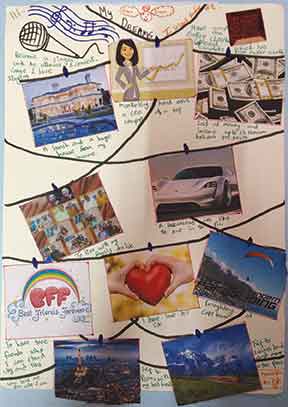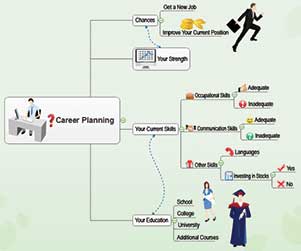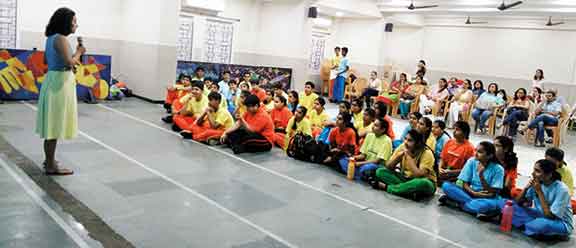Lamia Bagasrawala
The teenage years are characterized by extensive opportunities for growth, creativity and innovation. At the same time, it is a period of complex physical and socio-emotional changes that can result in confusion and distress. As students transition into high school they begin to engage with questions about their identity and their future roles in society. One of the many areas of deliberation for adolescents, apart from social roles and sexual and gender identities, is professional roles and career goals. This becomes the central theme for most discussions and decisions in an adolescent’s life during high school. Parents and families are concerned about their children’s future and often rely on schools to provide them with appropriate guidance. Choosing a career isn’t a simple process and yet it isn’t rocket science either! However, the lack of conversation about this process and the limited awareness about the possibilities in the field of work and employment often makes career decision-making seem like an insurmountable task. And most often, educators and schools find themselves outsourcing the task of career guidance to ‘experts’ and agencies who usually rely on standardized tools and individual guidance sessions with students and parents. While such objective assessments and professional guidance are required, it may not necessarily be the first step in the process. The role of schools in facilitating students’ career decision-making process is vast and requires involvement of various stakeholders including school leaders, teachers and parents.
During my experience of working as a psychologist with high school students, I began to explore the idea of integrating career guidance within the school curriculum. Here are a few activities and processes that were initiated in the school to guide students to explore and engage creatively in the process of deciding their future goals and way of life.
Skill focused discussions
India has a large demographic dividend, predictably making it one of the youngest countries in the world by 2020. However, while almost 12 million individuals are added to the workforce annually in India, there is a huge number which lacks the skills required for employment and even among those who are skilled, there is a mismatch between skills possessed and skills required (Parasuraman, 2017). According to NASSCOM only 25% of graduates in IT are readily employable, making it critical to bridge the skill gap (Julka & Mishra, 2011). It is important therefore, as educators, to realign our discussions and conversations toward skill development of students and prepare them for the employment market instead of focusing merely on academic performance and degrees. Simple worksheets or exercises such as creating mind-maps to help students identify and explore skill sets that are required for the kind of career they want offer a great starting point in the career decision-making process. The focus must be on both, technical skills as well as soft skills. Using a simple guide, like the list of marketable skills provided by Columbia University can facilitate this discussion within our classrooms. For instance, the guide enlists 108 skills which include essential employment skills like addressing groups of people, setting goals, following instructions, influencing others, communicating data, coping with difficulties, multi-tasking, etc. Discussions using such tools will help students identify skills that they would like to work on and parents, teachers and peers can help them on this journey.
 Vision boards
Vision boards
Vision boards are great practice for students to gain some clarity on different aspects of their life and also conceptualize their life as a combination of various elements. Vision boards are a visual representation of an individual’s dreams, what one wants to be and the kind of life one wishes to live. It is often made as a collage by sticking together pictures that represent the individual’s wishes, sometimes accompanied by drawing or writing. The idea of vision boards is based on the principles of law of attraction and visualization, a mind exercise particularly famous among athletes (LeVan, 2009) and Olympians (Clarey, 2014). As Patti Dobrowolski, a featured TEDx speaker, visual goal setter and business consultant recommends, imagining, visualizing and drawing one’s future can create many possibilities and change one’s life. However, there is also evidence which describes the possible negative impact or lack of positive effects of a vision board (Farber, 2012). It is important therefore to consider a vision board as a guiding document in the career decision process. The focus must therefore be on larger visions or dreams, beliefs, thoughts and feelings associated with these dreams rather than specific goals. A template for incorporating vision boards in a classroom setup has been provided by the Durham District School Board. The rubric and categories provided can serve as a great starting tool which can be adapted to the school’s needs and socio-cultural context. When conducted in the class, the process helps students reflect on varied aspects of their life, re-prioritize and identify the coherence and dissonance between their existing choices and future dreams. Each student can also be provided with detailed feedback and exploratory questions based on their vision boards to continue the process of reflection.
 Career mapping
Career mapping
Once students have reflected on their skills and captured their dreams in a visual representation, it’s a great idea to help them track the path that will lead them to those dreams. A career map allows the student to see where they are and identify all the roads that lead them to their ultimate goal. It involves identification of short-term and long-term goals. Sometimes, adopting a ‘working backward’ approach will also help students identify the most immediate steps they need to take across the three domain areas – building knowledge, developing skills and strengthening values – required for their future professional goal or dream. Students who are unclear of their profession or career goal, can create a map for each of these goals. This will also help them identify any common areas of knowledge or skills that will help them across multiple careers. Templates of career maps are often available online and can be adapted to the school context. In order to facilitate healthy reflection, the teacher or counsellor facilitating the session may also create a career map for their own professional journey.
Conversational spaces
The concept of ‘career days’ is quite common in universities and colleges. However, we rarely hear of such spaces in the context of schools in India. These spaces are great platforms for students to interact with those in different educational and professional spaces and learn more about the contextual realities, prospects and challenges. Such information is rarely available in online and offline resources or directories. In an attempt to create such spaces, to bridge the gap between the ‘employment space’ and the ‘education space’, we organized a series of interactions with experts spanning three days. The sessions were organized within the school premises during school hours to ensure that all students could attend. Professionals and experts from varied backgrounds including digital media, engineering, art, law, archaeology, film and entrepreneurship among others interacted with students of class 10 and their parents, providing them with a glimpse of their own journeys, the challenges they encountered, their successes and their informed advice regarding their profession. These interactions led to thought-provoking discussions driven by a deep curiosity among the students as well as their families. Here’s what some of the speakers, students and parents have to share about these interactions…
“These practices are important because nowadays children have a lot of fields to choose from and also have many options within each field. So these talks basically help children like us to explore a particular career without actually getting into it which is done by listening to the success and regret stories of people who have actually gone through it. This turns into a guideline that helps us through our journey of life and selection of our career. It acts as a time lapse in future giving us a ‘rough’ sketch as to how our life would be and what challenges would we have to face if we select that particular path in life.” – Manav Parab, Class 10 (2016-17), Shishuvan School
“I loved interacting with the children at Shishuvan. To let them know that they can start early or late, it’s okay. That they can fail, and it’s okay. That they can change their mind in the middle and even that is okay. I firmly feel that such interactions will allow a child to break free of stereotypes and boxes. It can answer unasked questions and also help validate some of their aspirations and hopes.” – Ishita Manek, Speaker and Co-founder Rubaroo, NGO that works to eliminate Child Sexual Abuse
“In most of the schools in India, students are unaware about career choices beyond engineering, medical and, the notable few. Such interactions with professionals from other diverse fields opened up horizons of thoughts for youngsters. This enables them to make a more informed choice after learning about other career paths. I hope these interactions are consistently organised for nurturing future mavericks across industries.” – Harsh Desai, Speaker and Senior Partner, Tilt Shift Media LLP
“It was a great experience for children to directly come in contact with experts from different professions. The resource persons have very well explained the pros and cons about their path of education and also shared how students can pursue different streams. After attending these sessions, I realized that following one’s passion and dream in whatever stream one is doing is important. I strongly recommend parents to attend such workshops and take maximum benefit from it. And schools should provide these for the children.” – Rekha Shah, Parent of student in class 10 (2016-17), Shishuvan School
“I feel it is a wise move for every school to help their children identify the possibilities and having a ‘Career Day’ is an excellent way of enabling the process. The opportunity to help children understand what the role of an HR Professional entails was therefore something I did not want to pass up on. It is the best feeling to stand there, looking at nearly a hundred faces looking back at you with wonder, catching every syllable you utter.” – Pranit Das, Speaker and Advisor, Entrepreneur, Fitness Buff
Individual guidance
Students who may need assistance in understanding more about specific professions as well as clarity about their skills and potential may be referred to career guidance experts and counsellors. Aptitude assessments followed by individual counselling with the students as well as involvement of families can facilitate the process of career decision-making and also help alleviate the distress that students and families may experience. For schools, it’s best to have a directory of career guidance counsellors or service providers who students can reach out to.
While these practices are extremely useful for students of Class 10, it’s recommended that these are initiated when students begin high school. Re-visiting these practices every academic year will help students gain more clarity and witness their dreams, thoughts and perspectives evolve over time.
References
- Clarey, C. (2014, February 22). Olympians use Imagery as Mental Training. The New York Times. Retrieved July 2017, from https://www.nytimes.com/2014/02/23/sports/olympics/olympians-use-imagery-as-mental-training.html?_r=0
- Farber, N. (2012, May 23). Throw Away Your Vision Board. Psychology Today. Retrieved July 2017, from https://www.psychologytoday.com/blog/the-blame-game/201205/throw-away-your-vision-board-0
- Vision Board Project – Handouts and Materials. (2016). Retrieved from Durham District School Board: https://portal.ddsb.ca/class/b8npmu3/Lists/HandoutsandMaterials/Forms/CurrentView.aspx
- How to create Career Plannning Mind Map. (n.d.). Retrieved from Edraw Visualization Solutions: https://www.edrawsoft.com/create-careerplanning-mindmap.php
- Julka, H., & Mishra, P. (2011, April 07). Only 25% IT graduates readily employable: Nasscom. The Economic Times. Retrieved July 2017, from http://economictimes.indiatimes.com/jobs/only-25-it-graduates-readily-employable-nasscom/articleshow/7894300.cms
- LeVan, A. (2009, December 03). Seeing Is Believing: The Power of Visualization. Psychology Today. Retrieved July 2017, from https://www.psychologytoday.com/blog/flourish/200912/seeing-is-believing-the-power-visualization
- Office of Career Services. (n.d.). Retrieved from Teachers College Columbia University: http://www.tc.columbia.edu/career-services/resources/
- Parasuraman, S. (2017, February 25). Can India Be A Beacon Of Hope For The World? Economic & Political Weekly, 52(8). Retrieved from http://www.epw.in/journal/2017/7/web-exclusives/can-india-be-beacon-hope-world.html
The author is a Clinical Psychologist practicing in Mumbai. She is a Mental Health Consultant for the UNFPA-TISS Centre of Excellence on Adolescents and Youth (CoEAY) where she is engaged with the School Initiative for Mental Health Advocacy (SIMHA) programme. This piece was conceptualized when she was working as a School Psychologist at Shishuvan School, Mumbai. She can be reached at lamia.bagasrawala@gmail.com.

